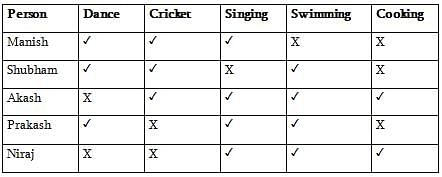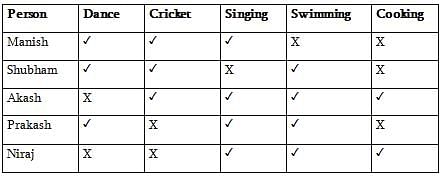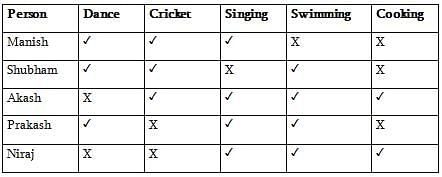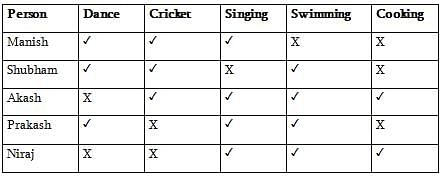APPSC (Arunachal Pradesh) Prelims Paper 2 Mock Test- 8 - APPSC (Arunachal Pradesh) MCQ
30 Questions MCQ Test APPSC (Arunachal Pradesh) Mock Test Series 2025 - APPSC (Arunachal Pradesh) Prelims Paper 2 Mock Test- 8
P2 Read the following information carefully and answer the questions given below it.
Eight students A, B, C, D, E, F, G and H are planning to enjoy car racing. There are only two cars and following are the conditions.
- One car can accommodate maximum five and minimum four students.
- A will sit in the same car in which D is sitting but H is not in the same car.
- B and C cannot sit in the same car in which D is sitting.
- F will sit in the car of four people only along with A and E but certainly not with G.
If H and G are sitting in the same car, who are other two students sitting in the same car?
Eight students A, B, C, D, E, F, G and H are planning to enjoy car racing. There are only two cars and following are the conditions.
P2 Read the following information carefully and answer the questions given below it.
Eight students A, B, C, D, E, F, G and H are planning to enjoy car racing. There are only two cars and following are the conditions.
- One car can accommodate maximum five and minimum four students.
- A will sit in the same car in which D is sitting but H is not in the same car.
- B and C cannot sit in the same car in which D is sitting.
- F will sit in the car of four people only along with A and E but certainly not with G.
If E and A are sitting in the same car, which of the following statements is true?
Eight students A, B, C, D, E, F, G and H are planning to enjoy car racing. There are only two cars and following are the conditions.
P2 Read the following information carefully and answer the questions given below it.
Eight students A, B, C, D, E, F, G and H are planning to enjoy car racing. There are only two cars and following are the conditions.
- One car can accommodate maximum five and minimum four students.
- A will sit in the same car in which D is sitting but H is not in the same car.
- B and C cannot sit in the same car in which D is sitting.
- F will sit in the car of four people only along with A and E but certainly not with G.
Which of the following statements is superfluous for the above sitting arrangements ?
Eight students A, B, C, D, E, F, G and H are planning to enjoy car racing. There are only two cars and following are the conditions.
A survey conducted in Britain confirmed that an abnormally high percentage of patients suffering from arthritis of the spine who had been treated with X rays contracted cancer. Another study revealed a high incidence of childhood cancer in cases where the mother had been given prenatal pelvic X rays. These studies have pointed to the need to re-examine the assumption that exposure to low-linear energy transfer presents only a minor risk. Recently, examination of the death certificates of former employees of a West Coast plant that produces plutonium for nuclear weapons revealed markedly higher rates for cancers of the pancreas, lung, bone marrow, and lymphatic system than would have been expected in a normal population. While the National Academy of Sciences committee attributes this difference to chemical or other environmental causes rather than radiation, other scientists maintain that any radiation exposure, no matter how small, leads to an increase in cancer risk. It is believed by some that a dose of one rem, if sustained over many generations, would lead to an increase of 1 percent in the number of serious genetic defects at birth, a possible increase of 1,000 disorders per million births.
According to the passage, some scientists believe that a dose of one rem of radiation continued over a period of generations would
A survey conducted in Britain confirmed that an abnormally high percentage of patients suffering from arthritis of the spine who had been treated with X rays contracted cancer. Another study revealed a high incidence of childhood cancer in cases where the mother had been given prenatal pelvic X rays. These studies have pointed to the need to re-examine the assumption that exposure to low-linear energy transfer presents only a minor risk. Recently, examination of the death certificates of former employees of a West Coast plant that produces plutonium for nuclear weapons revealed markedly higher rates for cancers of the pancreas, lung, bone marrow, and lymphatic system than would have been expected in a normal population. While the National Academy of Sciences committee attributes this difference to chemical or other environmental causes rather than radiation, other scientists maintain that any radiation exposure, no matter how small, leads to an increase in cancer risk. It is believed by some that a dose of one rem, if sustained over many generations, would lead to an increase of 1 percent in the number of serious genetic defects at birth, a possible increase of 1,000 disorders per million births.
The passage implies that each of the following statements about radiation has been disputed EXCEPT?
An Employer pays Rs. 15 for each day a worker works, and forfeits Rs. 5 for each day he is idle. At the end of 40 days, a worker gets Rs. 160. For how many days did the worker remain idle?
The ratio between the length and the breadth of a rectangular park is 4: 1. If a man cycling along the boundary of the park at the speed of 15 km/hr completes one round in 10 minutes, then the length of the park (in sq. m) is:
An error 3% in excess is made while measuring the side of a square. The percentage of error in the calculated area of the square is:
For some time, scientists have believed that cholesterol plays a major role in heart disease because people with familial hypercholesterolemia, a genetic defect, have six to eight times the normal level of cholesterol in their blood and they invariably develop heart disease. Scientists also noticed that people with familial hypercholesterolemia appear to produce more LDL’s (low-density lipoproteins) than normal individuals. However, scientists wondered, could a genetic mutation that causes a slowdown in the removal of LDL’s from the blood also result in an increase in the synthesis of this cholesterol-carrying protein? Since scientists could not experiment on human body tissue, their knowledge of familial hypercholesterolemia was severely limited. However, a breakthrough came in the laboratories of Yoshio Watanabe of Kobe University in Japan in 1980. Watanabe noticed that a male rabbit in his colony had ten times the normal concentration of cholesterol in its blood. By appropriate breeding, Watanabe obtained a strain of rabbits that had very high cholesterol levels. These rabbits spontaneously developed heart disease. To his surprise, Watanabe further found that the rabbits, like humans with familial hypercholesterolemia, lacked LDL receptors. What scientists learned by studying the Watanabe rabbits is that the removal of the VLDL (very low-density lipoproteins) remnant requires the LDL receptor. Normally, the majority of the VLDL remnants go to the liver where they bind to LDL receptors and are degraded. In the Watanabe rabbit, due to a lack of LDL receptors on liver cells, the VLDL remnants remain in the blood and are eventually converted to LDL’s. The LDL receptors thus have a dual effect in controlling LDL levels. They are necessary to prevent over synthesis of LDL’s from VLDL remnants and they are necessary for the normal removal of LDL’s from the blood.
Q. The passage supplies information to answer which of the following questions?
For some time, scientists have believed that cholesterol plays a major role in heart disease because people with familial hypercholesterolemia, a genetic defect, have six to eight times the normal level of cholesterol in their blood and they invariably develop heart disease. Scientists also noticed that people with familial hypercholesterolemia appear to produce more LDL’s (low-density lipoproteins) than normal individuals. However, scientists wondered, could a genetic mutation that causes a slowdown in the removal of LDL’s from the blood also result in an increase in the synthesis of this cholesterol-carrying protein? Since scientists could not experiment on human body tissue, their knowledge of familial hypercholesterolemia was severely limited. However, a breakthrough came in the laboratories of Yoshio Watanabe of Kobe University in Japan in 1980. Watanabe noticed that a male rabbit in his colony had ten times the normal concentration of cholesterol in its blood. By appropriate breeding, Watanabe obtained a strain of rabbits that had very high cholesterol levels. These rabbits spontaneously developed heart disease. To his surprise, Watanabe further found that the rabbits, like humans with familial hypercholesterolemia, lacked LDL receptors. What scientists learned by studying the Watanabe rabbits is that the removal of the VLDL (very low-density lipoproteins) remnant requires the LDL receptor. Normally, the majority of the VLDL remnants go to the liver where they bind to LDL receptors and are degraded. In the Watanabe rabbit, due to a lack of LDL receptors on liver cells, the VLDL remnants remain in the blood and are eventually converted to LDL’s. The LDL receptors thus have a dual effect in controlling LDL levels. They are necessary to prevent over synthesis of LDL’s from VLDL remnants and they are necessary for the normal removal of LDL’s from the blood.
Q. According to the passage, by studying the Watanabe rabbits’ scientists learned that
For some time, scientists have believed that cholesterol plays a major role in heart disease because people with familial hypercholesterolemia, a genetic defect, have six to eight times the normal level of cholesterol in their blood and they invariably develop heart disease. Scientists also noticed that people with familial hypercholesterolemia appear to produce more LDL’s (low-density lipoproteins) than normal individuals. However, scientists wondered, could a genetic mutation that causes a slowdown in the removal of LDL’s from the blood also result in an increase in the synthesis of this cholesterol-carrying protein? Since scientists could not experiment on human body tissue, their knowledge of familial hypercholesterolemia was severely limited. However, a breakthrough came in the laboratories of Yoshio Watanabe of Kobe University in Japan in 1980. Watanabe noticed that a male rabbit in his colony had ten times the normal concentration of cholesterol in its blood. By appropriate breeding, Watanabe obtained a strain of rabbits that had very high cholesterol levels. These rabbits spontaneously developed heart disease. To his surprise, Watanabe further found that the rabbits, like humans with familial hypercholesterolemia, lacked LDL receptors. What scientists learned by studying the Watanabe rabbits is that the removal of the VLDL (very low-density lipoproteins) remnant requires the LDL receptor. Normally, the majority of the VLDL remnants go to the liver where they bind to LDL receptors and are degraded. In the Watanabe rabbit, due to a lack of LDL receptors on liver cells, the VLDL remnants remain in the blood and are eventually converted to LDL’s. The LDL receptors thus have a dual effect in controlling LDL levels. They are necessary to prevent over synthesis of LDL’s from VLDL remnants and they are necessary for the normal removal of LDL’s from the blood.
Q. The passage implies that Watanabe rabbits differ from normal rabbits in which of the following ways?
"I want to criticize the social system, and to show it at work, at its most intense." Virginia Woolf’s provocative statement about her intentions in writing Mrs. Dalloway has regularly been ignored by the critics, since it highlights an aspect of her literary interests very different from the traditional picture of the "poetic” novelist concerned with examining states of reverie and vision and with following the intricate pathways of individual consciousness. In her novels, Woolf is deeply engaged by the questions of how individuals are shaped (or
deformed) by their social environments, how historical forces impinge on people’s lives, how class, wealth, and gender help to determine people’s fates. Most of her novels are rooted in a realistically rendered social setting and in a precise historical time.Woolf’s focus on society has not been generally recognized because of her intense antipathy to propaganda in art. The pictures of reformers in her novels are usually satiric or sharply critical.Woolf detested what she called "preaching" in fiction, too, and criticized novelist D. H. Lawrence (among others) for working by this method. Woolf’s own social criticism is expressed in the language of observation rather than in direct commentary, since for her, fiction is a contemplative, not an active art. Woolf’s literary models were acute social observers like Chekhov and Chaucer. As she put it in The Common Reader, "It is safe to say that not a single law has been framed or one stone set upon another because of anything Chaucer said or wrote; and yet, as we read him, we are absorbing morality at every pore."
Q. It can be inferred from the passage that Woolf chose Chaucer as a literary model because she believed that
"I want to criticize the social system, and to show it at work, at its most intense." Virginia Woolf’s provocative statement about her intentions in writing Mrs. Dalloway has regularly been ignored by the critics, since it highlights an aspect of her literary interests very different from the traditional picture of the "poetic” novelist concerned with examining states of reverie and vision and with following the intricate pathways of individual consciousness. In her novels, Woolf is deeply engaged by the questions of how individuals are shaped (or
deformed) by their social environments, how historical forces impinge on people’s lives, how class, wealth, and gender help to determine people’s fates. Most of her novels are rooted in a realistically rendered social setting and in a precise historical time.Woolf’s focus on society has not been generally recognized because of her intense antipathy to propaganda in art. The pictures of reformers in her novels are usually satiric or sharply critical.Woolf detested what she called "preaching" in fiction, too, and criticized novelist D. H. Lawrence (among others) for working by this method. Woolf’s own social criticism is expressed in the language of observation rather than in direct commentary, since for her, fiction is a contemplative, not an active art. Woolf’s literary models were acute social observers like Chekhov and Chaucer. As she put it in The Common Reader, "It is safe to say that not a single law has been framed or one stone set upon another because of anything Chaucer said or wrote; and yet, as we read him, we are absorbing morality at every pore."
Q. It can be inferred from the passage that the most probable reason Woolf realistically described the social setting in the majority of her novels was that she
Direction: In a world cup tournament 16 teams participated. These 16 teams are seeded from 1 to 16 with seed 1 being the top seed and seed 16 being the bottom seed. The tournament is conducted in different stages. In stage 1 seed 1 played with seed 16 and that match is named as match 1 of stage 1, seed 2 played with seed 15 and that match is named as match 2 of stage 1, and so on. In stage 2, winner of match 1 and match 8 of stage 1 played against each other and that match is named as Match 1 of stage 2, then winner of match 2 and match 7 of stage 1 played against each other and that match is named as Match 2 of stage 2. And so on The same procedure is followed in further stages. Now answer the following questions.
Q. How many stages are in the tournament?
Direction: In a world cup tournament 16 teams participated. These 16 teams are seeded from 1 to 16 with seed 1 being the top seed and seed 16 being the bottom seed. The tournament is conducted in different stages. In stage 1 seed 1 played with seed 16 and that match is named as match 1 of stage 1, seed 2 played with seed 15 and that match is named as match 2 of stage 1, and so on. In stage 2, winner of match 1 and match 8 of stage 1 played against each other and that match is named as Match 1 of stage 2, then winner of match 2 and match 7 of stage 1 played against each other and that match is named as Match 2 of stage 2. And so on The same procedure is followed in further stages. Now answer the following questions.
Q. What is the total number of matches in the tournament?
Statement: Most of those who study in premier medical colleges in India migrate to Russia for better prospects in their professional pursuits.
Courses of Action:
All the students joining these colleges should be asked to sign a bond at the time of admission to the effect that they will remain in India at least for ten years after they complete education.
All those students who desire to settle in Russia should be asked to pay entire cost of their education which the government subsidies.
Directions: Study the following information carefully and answer the questions that follow.
Manish and Shubham are good in Dance and Cricket. Akash and Manish are good in Cricket and Singing. Akash, Prakash and Niraj are good in Singing and Swimming. Niraj and Akash are good in Singing and Cooking. Prakash and Shubham are good in Swimming and Dance.
Who is good in Cricket, Swimming and Dance?
Directions: Study the following information carefully and answer the questions that follow.
Manish and Shubham are good in Dance and Cricket. Akash and Manish are good in Cricket and Singing. Akash, Prakash and Niraj are good in Singing and Swimming. Niraj and Akash are good in Singing and Cooking. Prakash and Shubham are good in Swimming and Dance.
Who is good in Singing, Dance and Cricket?
Directions: Study the following information carefully and answer the questions that follow.
Manish and Shubham are good in Dance and Cricket. Akash and Manish are good in Cricket and Singing. Akash, Prakash and Niraj are good in Singing and Swimming. Niraj and Akash are good in Singing and Cooking. Prakash and Shubham are good in Swimming and Dance.
Who is good in Singing, Swimming and Dance?
Directions: Study the following information carefully and answer the questions that follow.
Manish and Shubham are good in Dance and Cricket. Akash and Manish are good in Cricket and Singing. Akash, Prakash and Niraj are good in Singing and Swimming. Niraj and Akash are good in Singing and Cooking. Prakash and Shubham are good in Swimming and Dance.
Who is good in Singing, Swimming and Cooking but not in Cricket?
find the least value of “b” for which 67b326 is divisible by 3?
Greek architecture of the great age is the expression of men who were, first of all, intellectual artists, kept firmly within the visible world by their mind, but, only second to that, lovers of the human world. The Greek temple is the perfect expression of the pure intellect illumined by the spirit. No other great buildings anywhere approach its simplicity. In the Parthenon straight columns rise to plain capitals; a pediment is sculptured in bold relief; there is nothing more. And yet-here is the Greek miracle this absolute simplicity of structure is alone in majesty of beauty among all the temples and cathedrals and palaces of the world. Majestic but human, truly Greek. No superhuman force as in Egypt; no strange supernatural shapes as in India; the Parthenon is the home of humanity at ease, calm, ordered, sure of itself and the world. The Greeks flung a challenge to nature in the fullness of their joyous strength. They set their temples on the summit of a hill overlooking the wide sea, outlined against the circle of the sky. They would build what was more beautiful than hill and sea and sky and greater than all these. It matters not at all if the temple is large or small; one never thinks of the size. It matters not how much it is in ruins. A few white columns dominate the lofty height at Sounion as securely as the great mass of the Parthenon dominates all the sweep of sea and land around Athens. To the Greek architect man was the master of the world. His mind could understand its laws; his spirit could discover its beauty
The Greeks flung a challenge to nature in the fullness of their joyous strength.” Which of the following best captures the 'challenge' that is being referred to?
Of the 1300 candidates, who were interviewed for a position at a Bank, 900 had a Car, 630 had a motorcycle and 690 had a mobile phone. 300 of them had both, a Car and a motorcycle, 230 had both, a motorcycle and a mobile phone and 360 had both, a Car and mobile phone and 100 had all three. How many candidates had none of the three?
The ratio of Adam’s age 4 years ago and Eve’s age after 4 years is 1: 1. Presently, the ratio of their ages is 4 : 3. Find the ratio between Adam’s age 4 years hence and Eve’s age 4 years
Directions for following 4(four) questions:
Following chart indicates internal division of electricity usage for two years. Study the graph carefully and answer questions given below.
Q. If consumption in one sector is increased it will be marked 2 and decreased then by -1. If it remained unchanged then it will marked as 0. What is total of all 6 sectors?
Following chart indicates internal division of electricity usage for two years. Study the graph carefully and answer questions given below.
Q. Total electricity consumption in 2012 is 1.5 times of the total electricity consumption in 2011, then what is percentage increase in the electricity consumption of the agricultural sector?
Following chart indicates internal division of electricity usage for two years. Study the graph carefully and answer questions given below.
Q. What is maximum number of sectors one should add to cross 50% consumption for 2012 year?
Following chart indicates internal division of electricity usage for two years. Study the graph carefully and answer questions given below.
Q. The agricultural consumption of electricity doubled for given years. By how much percentage has the total electricity consumption grown up?
How many solutions do the equation 1/x + 1/(x + 1) = 1/3 have?
Let f(x) = 2x + 4. Which of the following statements is true?








 =
=  =
= 















